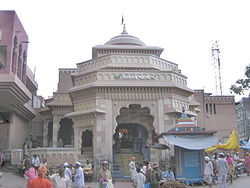 It is a break from a centuries-old tradition that promises to be for a socially inclusive cause. Last weekend, when the authorities at the Vitthal Rukmini Temple Trust in Pandharpur conducted interviews of candidates vying for the position of the temple priests, the caste of the candidate was set aside. In a landmark move, the revered temple will allow “practicing Hindus” across the caste system-and women-to perform religious rituals as priests. For centuries, Brahmins have enjoyed total monopoly over the temple’s rituals. These new priests, however, need to be well versed in temple rituals and special pujas for the presiding deity. Anna Dange, head of the temple committee explained the decision as a move to ensure that “no single caste of group of people can claim monopoly on serving God.”
It is a break from a centuries-old tradition that promises to be for a socially inclusive cause. Last weekend, when the authorities at the Vitthal Rukmini Temple Trust in Pandharpur conducted interviews of candidates vying for the position of the temple priests, the caste of the candidate was set aside. In a landmark move, the revered temple will allow “practicing Hindus” across the caste system-and women-to perform religious rituals as priests. For centuries, Brahmins have enjoyed total monopoly over the temple’s rituals. These new priests, however, need to be well versed in temple rituals and special pujas for the presiding deity. Anna Dange, head of the temple committee explained the decision as a move to ensure that “no single caste of group of people can claim monopoly on serving God.”
For centuries, devotees cutting across caste and creed have thronged to this temple in the town of Pandharpur to pay obeisance to Vithoba and Rukmini. One of the most important religious festivals in Maharashtra is the annual Pandharpur wari or yatra, a tradition that is centuries old. Millions of devotees, or waris, join this month-long pilgrimage every year, walking to the shrine, chanting bhajans and camping along the way. It is believed that the tradition of the wari was started by Sant Tukaram over 800 years ago when he set out with other devotees for the pilgrimage. The tradition has been unbroken since then with generations of families religiously joining the wari every year. the Mumbai’s dabbawalas, are known to take the entire month off to walk to the Pandharpur shrine every year. The importance of the temple and the pilgrimage is such that on the occasion of Ashadi Ekadashi, the chief minister of the Maharashtra, conducts the puja at the temple.
To prevent the traditional monopoly of the Brahmin men over religious rituals in shrines, a few social organizations and groups have been training women and members of non-Brahmin castes in reciting and performing rituals.
In April 2011, the 1100-year-old Mahalakshmi temple in Kolhapur created history by allowing women to enter the sanctorum, which was earlier frowned upon. Interestingly, the historic shift took place a day after the state legislature passed the Women’s Reservation Bill.
For the first time in 900 years, the revered Vithoba temple in Pandharpur is set to allow ‘lower caste’ and women priests to conduct pujas. In keeping with demands to break the monopoly of the Brahmins over the temple’s rituals, the temple has invited applications from practicing Hindus of all castes. The temple is best known for the annual Pandharpur yatra where lakhs of devotees walk over 200 km to the shrine during the festival every year.





